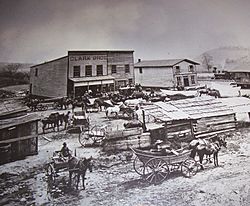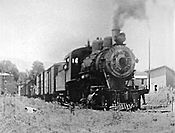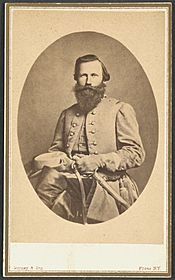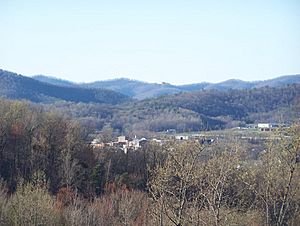Stuart, Virginia facts for kids
Quick facts for kids
Stuart, Virginia
|
|
|---|---|
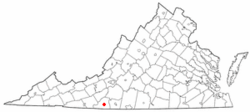
Location of Stuart, Virginia
|
|
| Country | United States |
| State | Virginia |
| County | Patrick |
| Founded | 1792 |
| Government | |
| • Type | Mayor-Council |
| Area | |
| • Total | 3.04 sq mi (7.87 km2) |
| • Land | 3.04 sq mi (7.87 km2) |
| • Water | 0.00 sq mi (0.00 km2) |
| Elevation | 1,345 ft (410 m) |
| Population
(2010)
|
|
| • Total | 1,408 |
| • Estimate
(2019)
|
1,271 |
| • Density | 418.37/sq mi (161.53/km2) |
| Time zone | UTC−5 (Eastern (EST)) |
| • Summer (DST) | UTC−4 (EDT) |
| ZIP code |
24171
|
| Area code(s) | 276 |
| FIPS code | 51-76256 |
| GNIS feature ID | 1500182 |
| Website | http://www.patrickchamber.com/ |
Stuart is a town in Patrick County, Virginia, where it is the county seat. The population was 1,408 at the 2010 census. The town of Stuart was named after Confederate Gen. J.E.B. Stuart, of nearby Ararat, Virginia.
Contents
History
Incorporation (1753–1830)
The Town of Stuart was first incorporated as Taylorsville, Virginia, in 1792, in honor of early settler George Taylor. Stuart has been the county seat of Patrick County since the county's formation from Henry County, Virginia in 1791. With the Patrick County Courthouse at its center, the Stuart Uptown Historic District encompasses the historic core of the county seat and includes government, financial, religious, and commercial buildings dating from the mid-nineteenth to the mid-twentieth centuries.
Antebellum (1831–1860)
By 1850, Taylorsville had grown to include approximately 50 dwellings and businesses. The 1850 census reported 18 households with 50 adults (including 29 boarders) and 60 children living in the area of the courthouse. Occupations listed included four farmers, two innkeepers, three merchants, attorneys, two physicians, two cabinetmakers, two saddlers, one harness maker, three tailors, one bricklayer, nine laborers, a clerk, a mail carrier, and a sheriff with two deputies. The Danville and Wytheville Turnpike, following present-day Virginia State Route 8, was established in the 1850s. In 1848, the Richmond and Danville Railroad was chartered, and tracks were completed to Danville by 1856.
War, reconstruction and growth (1860–1916)
Following the economic difficulties of the war, the residents of Taylorsville focused their energies on expanding railroads to boost the economy. The Danville and New River Railroad was chartered in 1873, with the line completed to Martinsville, Virginia in nearby Henry County by 1881. In 1883, citizens of Patrick County approved a bond of $150,000 to expand the line. The first train pulled into Taylorsville in August 1884. With the growth associated with the railroad, Taylorsville was incorporated as a town in 1884 and was renamed Stuart in honor of Confederate Major General J.E.B. Stuart, who was born 20 miles west of town in Ararat, Virginia.
Following the completion of the railroad, the town of Stuart continued to grow steadily. The population increased 25% from 300 in 1884 to 371 in 1900. While occupations continued to center around the courthouse activities and the typical needs of a community, the 1900 census reflects the influence of the railroad by citing four railroad employees, eight salesmen, one insurance agent, one mining engineer, and one timber dealer. Five teachers, three hotels, two druggists, and two bartenders also indicate the growth of the town. The construction of the railroad led to the distinction of "uptown" and "downtown" Stuart, since the original courthouse village was situated at the crest of a hill and an industrial and commercial area developed adjacent to the railroad, which was located further downhill along the Mayo River. "Uptown" continued to serve as the center of the town with the courthouse, churches, school, attorneys' offices, banks, hotels, and stores. The two areas, however, were closely related and interdependent as is evidenced by the town's first telephone line at the turn of the twentieth century being run between the railroad depot downtown and the Hotel Perkins uptown.
World War I to World War II (1917–1945)
Before 1915, no public water or sewer system was available, and water came from private wells or from nearby springs. There were no streetlights, and oil lamps were used for interior lighting, the roads were unpaved and the sidewalks were wooden. After the water system was installed, it was well received, but by 1926 the population of the town had increased so much that improvements needed to be made. In 1916, the Clark Power and Light Company established the first electric light system in Stuart. Each customer was charged a flat rate of $1.25 per month, and if 300 citizens bought into the system, Clark would allow the lights to burn all night. The Stuart Power and Light Company bought them out, and they were then sold to the Virginia East Coast Utilities Company, and in 1938, the Appalachian Electric Power Company bought them out. Joseph H. Vipperman, a Stuart native, was the president of this company when its name was changed to American Electric Power. The first telegraph came to Stuart with the railroad in 1884, and reportedly the first telephone was operated at the Hotel Perkins. By 1923, ten lines served the county, each with a central; the Stuart central was located in the home of Walter S. Gilbert. In 1937, the Lee Telephone Company acquired all the private lines. In 1974, the Central Telephone Company of Virginia bought out the Lee Company where years after, Sprint/Centel bought them out and now Centurylink serves Patrick County.
Travel to Stuart was difficult until the first hard-paved road reached Stuart from Martinsville in 1925. In 1929, a nine-mile stretch from Stuart to the North Carolina state line south was covered. In 1930, the three miles to Cruzes (Cruises) Store was paved, and in 1932, the road was extended to Hillsville, Virginia. Today, State Routes 8 and U.S. Route 58 serve the town and the county and other counties along its east-to-west stretch. Today, Route 58 is a four-lane divided highway, crossing the entire Commonwealth, as well as Patrick County.
By 1940, the population of Stuart had increased to 600 and the majority of the buildings standing today were already constructed. The Patrick County Bank (established in 1890 and later merged with the Bank of Stuart in 1926) constructed its large Classical building directly across from the courthouse in 1911. The two uptown churches, Stuart United Methodist Church and the Stuart Baptist Church, constructed their present-day structures in the early twentieth-century.
Present day
Today, Stuart experiences a dynamic setting for all age groups. With a burgeoning downtown and recent retail developments along the Highway 58 corridor, the town has forged a path success for many years to come. The new additions of the downtown rail trail along the Mayo River, a new Farmer's Market located within the heart of town, and new sidewalk and infrastructural improvements along Main Street have all provided to the enhancement of the town of Stuart.
The Stuart Uptown Historic District, Goblintown Mill, and Patrick County Courthouse are listed on the National Register of Historic Places.
Geography
Stuart is located at 36°38′25″N 80°16′26″W / 36.64028°N 80.27389°W (36.640197, −80.273940).
According to the United States Census Bureau, the town has a total area of 0.7 square miles (1.9 km²), all of it land.
0.7 square miles (1.8 km2)
The town of Stuart is a hilly community within a small valley surrounded by the Blue Ridge Mountains. The Mayo River runs through the heart of town, down through Patrick County.
Climate
| Stuart, VA Weather Base Recent Averages | ||||
|---|---|---|---|---|
| Average Yearly Rainfall Amount-51.3 Inches | Jan Temps, 26 to 45 F | April Temps, 43 to 67 F | July Temps, 67 to 90 F | October Temps, 45 to 68 F |
Demographics
| Historical population | |||
|---|---|---|---|
| Census | Pop. | %± | |
| 1890 | 332 | — | |
| 1900 | 371 | 11.7% | |
| 1910 | 388 | 4.6% | |
| 1920 | 401 | 3.4% | |
| 1930 | 588 | 46.6% | |
| 1940 | 720 | 22.4% | |
| 1950 | 849 | 17.9% | |
| 1960 | 974 | 14.7% | |
| 1970 | 947 | −2.8% | |
| 1980 | 1,131 | 19.4% | |
| 1990 | 965 | −14.7% | |
| 2000 | 961 | −0.4% | |
| 2010 | 1,408 | 46.5% | |
| 2019 (est.) | 1,271 | −9.7% | |
| U.S. Decennial Census | |||
As of the 2010 census, there were 1,408 people, 629 households, and 315 families residing in the town. The population density was 1,301.5 people per square mile (501.4/km2). There were 726 housing units at an average density of 698.8 per square mile (269.2/km2). The racial makeup of the town was 86.4% White, 8.9% African American, 1.8% from other races, and 1.5% from two or more races. Hispanic or Latino of any race were 3.1% of the population.
| Distance From Stuart and Population | |
|---|---|
| 5 Miles | 6,329 |
| 10 Miles | 15,594 |
| 20 Miles | 95,093 |
| 40 Miles | 824,396 |
| 50 Miles | 1,473,391 |
| https://www.census.gov/ | |
There were 449 households, out of which 25.8% had children under the age of 18 living with them, 35.9% were married couples living together, 14.7% had a female householder with no husband present, and 45.0% were non-families. 42.1% of all households were made up of individuals, and 19.8% had someone living alone who was 65 years of age or older. The average household size was 2.09 and the average family size was 2.85.
In the town, the population was spread out, with 22.4% under the age of 18, 9.3% from 18 to 24, 25.6% from 25 to 44, 23.0% from 45 to 64, and 19.8% who were 65 years of age or older. The median age was 40 years. For every 100 females, there were 85.5 males. For every 100 females age 18 and over, there were 82.8 males.
The median income for a household in the town was $20,192, and the median income for a family was $35,000. Males had a median income of $29,375 versus $19,938 for females. The per capita income for the town was $16,265. About 21.3% of families and 24.1% of the population were below the poverty line, including 36.2% of those under age 18 and 20.1% of those age 65 or over.
Notable residents
- Gerald Baliles, 65th governor of Virginia
- Martin Clark, author and Virginia Circuit Court judge
- Brad Clontz, professional baseball player
- Beatrice Farnham, artist
- Turner Foddrell, Piedmont blues and folk acoustic guitarist, singer and songwriter
- Chris Pritt, member of the West Virginia House of Delegates
- Mary Sue Terry, first female attorney general of Virginia
- Wood Brothers, the NASCAR team
Education
The Patrick County Public School System offers six elementary schools and one high school, with Stuart Elementary School and Patrick County High School lying within the town's boundaries. The high school, which serves approximately 1,000 students in grades 8–12, is fully accredited with the Southern Association of Colleges and Schools. Stuart Elementary provides a pre-kindergarten to seventh grade level education for approximately 500 students each year. The school consistently ranks within the top schools in Virginia in the Standards of Learning Testing program, as well as many other areas of academic excellence. Patrick County High School recently became District and Regional Academic Champions, as well as winning a plethora of accolades throughout the academic and athletic fields, such as Regional Cross Country Champions, District Football Champions, Regional Women's Basketball Champions, and multiple District Tennis Champions. They too have a proud academic history, and were also ranked as one of the top public high schools in the Commonwealth of Virginia. In their annual public high school rankings, U.S. News and World Report ranked Patrick County High School as one of the top schools in America.
See also
 In Spanish: Stuart (Virginia) para niños
In Spanish: Stuart (Virginia) para niños


